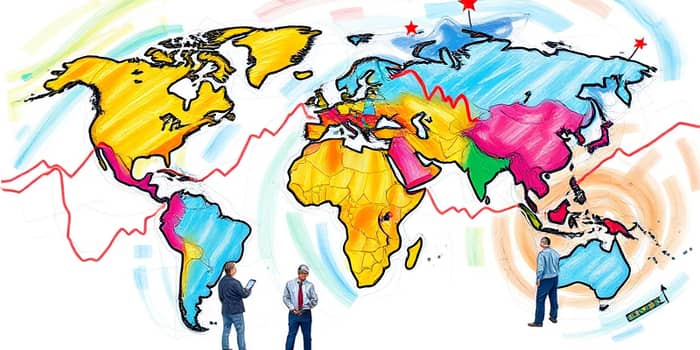In an era defined by rapid policy shifts and geopolitical uncertainties, understanding the forces that drive price swings in financial markets is more important than ever. Market participants—from individual investors to large institutions—must grasp the dynamics of volatility to navigate risk and seize opportunity.
This article offers a thorough, global perspective on volatility trends from 2017 through mid-2025, analyzes the catalysts behind the spikes of this year, and outlines practical strategies to manage turbulent markets.
Defining Market Volatility
Market volatility refers to the magnitude and frequency of price swings in asset values. It is a barometer of investor sentiment and perceived risk.
Three core metrics help quantify volatility:
- CBOE Volatility Index (VIX): Tracks expected 30-day volatility of the S&P 500 via options prices.
- Standard Deviation: Measures historical fluctuations in asset prices.
- MOVE Index: Captures volatility expectations in the fixed-income market.
Evolution of Volatility (2017–2025)
Over the past decade, volatility has oscillated through periods of calm and crisis. Following a relatively tranquil stretch in 2017 (average VIX 11.1), markets faced severe stress during the 2020 pandemic, with the VIX peaking at 85.5. In 2022, elevated inflation and interest-rate uncertainty drove averages to 25.6 before calming to 15.6 in 2024.
Mid-2025 has seen a resurgence, with an average VIX of 20.8 as of July, reflecting renewed trade tensions and geopolitical conflict.
2025: A Detailed Case Study
The first half of 2025 delivered a textbook example of how policy moves and global events can send shockwaves through markets. Investors experienced rapid sell-offs and equally swift recoveries as authorities negotiated trade terms and reassured stakeholders.
- Early April: VIX surged to 60.1 after sweeping U.S. tariffs on autos, electronics, and goods from major partners.
- April 9: Pause on further tariff hikes sparked the largest single-day equity gains in years.
- By June 27: Major U.S. indices, including the S&P 500 and NASDAQ, reached all-time highs.
These swings illustrated the interconnectedness of financial systems and trade networks, as ripples from Washington reverberated through Europe, Asia, and emerging markets.
Geopolitical and Macro Drivers
A confluence of factors underpins the current environment of uncertainty:
Global trade disputes have resurfaced as central banks and governments weigh the economic impact of tariffs and countermeasures. In parallel, conflicts in Eastern Europe and the Middle East continue to threaten energy supplies and shipping lanes, feeding into commodity price swings.
On the domestic front, central banks face the delicate task of balancing inflation control with growth support. Job creation has remained robust—125,000 positions in January and 151,000 in February—keeping unemployment at a steady 4.1%. Yet bond investors, sometimes called “bond vigilantes,” have driven yields higher on concerns over fiscal credibility and policy unpredictability.
Impact on Asset Classes
Volatility does not strike all markets equally:
Equities tend to experience sharp, sentiment-driven moves, with technology and consumer discretionary sectors swinging more violently than staples. Fixed income often sees rapid yield adjustments as investors reprioritize safety versus yield.
Commodities such as oil and agricultural products reflect both demand expectations and geopolitical risk. Emerging markets frequently display the highest volatility compared to developed economies, driven by political shifts and currency pressures, whereas U.S. Treasuries remain among the lowest volatility assets during periods of acute stress.
Global Perspective and Contagion
Market stress in one region can quickly transmit overseas. In April 2025, tariff-related losses in U.S. equities coincided with sell-offs in European stocks and local-currency outflows from Asia and Latin America. These episodes highlight how capital flows and trade linkages accelerate the spread of volatility.
Risk management strategies must therefore incorporate a global lens, recognizing that currencies, credit markets, and equity indices can all move in concert under stress.
Navigating Volatility: Lessons for Investors
Amid tumultuous markets, certain time-tested approaches can help preserve capital and capture upside potential:
- Emphasize diversification and risk management across asset classes and regions.
- Maintain liquidity buffers to capitalize on dislocations.
- Adopt a flight to safety and liquidity mindset during acute sell-offs.
- Use options and hedges tactically to protect portfolios without sacrificing upside.
- Focus on fundamentals: earnings growth, balance-sheet strength, and cash flow generation.
Looking Ahead: Prospects for Stabilization
The IMF projects global GDP growth of 3.0% in 2025 and 3.1% in 2026, suggesting resilient fundamentals despite ongoing volatility. However, risks remain substantial: policy reversals, fresh geopolitical flare-ups, and unexpected data surprises could reignite market swings.
Investors should monitor key indicators—central bank communications, tariff negotiations, and conflict developments—and remain prepared to adjust allocations swiftly. Those who combine disciplined risk controls with a long-term view are best positioned to thrive when calm returns.
References
- https://web.richardsonwealth.com/susan.daley/blog/1936744-Tuning-Out-the-Noise-How-to-Navigate-Market-Volatility-in-2025/
- https://www.diamond-hill.com/insights/a-780/articles/market-volatility-in-2025-tariffs-inflation-and-the-consumer-impact/
- https://www.visualcapitalist.com/charted-the-rise-of-stock-market-volatility-2017-2025/
- https://www.im.natixis.com/en-us/insights/macro-views/2025/get-ready-for-the-next-round-of-volatility
- https://en.wikipedia.org/wiki/2025_stock_market_crash
- https://www.schwab.com/learn/story/stock-market-outlook
- https://www.etftrends.com/etf-strategist-channel/market-volatility-early-2025-overview/
- https://www.fidelity.com/learning-center/trading-investing/volatility-2025










